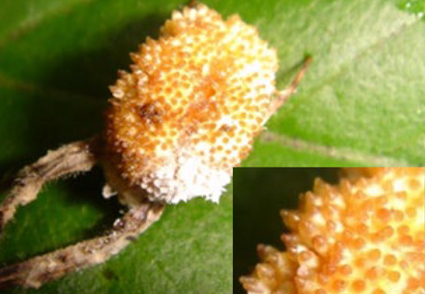Abstract
Gibellula is an exclusively spider-pathogen genus, with most species immediately recognized by their distinctive conidial state, but also including the teleomorphic states of these fungi that were previously included in the rejected genus Torrubiella. Two sexual specimens and an asexual morph specimen were collected from Anhui Province, China, and were recognized as the same species based on molecular evidence. Its asexual morph differs from Gibellula pulchra, to which it is morphologically similar, in having shorter verrucose conidiophores with slightly smaller metulae, phialides and conidia. Its sexual morph is characterized by producing superficial and elongate ellipsoid small perithecia with short asci on a cream-yellow mycelial mat covering the host. Multi-locus (SSU, LSU, TEF, and RPB1) phylogenetic analyses showed that the specimens belong to a strongly supported subclade, and formed a sister subclade with G. pulchra and Gibellula sp. A combination of morphological characteristics and its phylogenetic placement confirmed that these unique specimens are a new species, which is described as Gibellula flava.
References
Bischoff, J.F., Rehner, S.A. & Humber, R.A. (2009) A multilocus phylogeny of the Metarhizium anisopliae lineage. Mycologia 101: 512–530. https://doi.org/10.3852/07-202
Castlebury, L.A., Rossman, A.Y., Sung, G.H., Hyten, A.S. & Spatafora, J.W. (2004) Multigene phylogeny reveals new lineage for Stachybotrys chartarum, the indoor air fungus. Mycological Research 108: 864–872. https://doi.org/10.1017/s0953756204000607
Chen, W.H., Han, Y.F., Liang, J.D., Tian, W.Y. & Liang, Z.Q. (2020) Morphological and phylogenetic characterisations reveal three new species of Samsoniella (Cordycipitaceae, Hypocreales) from Guizhou, China. MycoKeys 74: 1–15. https://doi.org/10.3897/mycokeys.74.56655
Chirivi, J., Danies, G., Sierra, R., Schauer, N., Trenkamp, S., Restrepo, S. & Sanjuan, T. (2017) Metabolomic profile and nucleoside composition of Cordyceps nidus sp. nov. (Cordycipitaceae): a new source of active compounds. PLoS One 12: e0179428. https://doi.org/10.1371/journal.pone.0179428
Evans, H.C. (2013) Fungal pathogens of spiders. In: Nentwig, W. (Ed.) Spider ecophysiology. Springer, Berlin, Heidelberg, pp. 107–121. https://doi.org/10.1007/978-3-642-33989-99
Gardes, M. & Bruns, T.D. (1993) ITS primers with enhanced specificity for basidiomycetes –application to the identification of mycorrhizae and rusts. Molecular Ecology 2: 113–118. https://doi.org/10.1111/j.1365-294x.1993.tb00005.x
Hall, T. (2011) BioEdit: an important software for molecular biology. GERF Bulletin of Biosciences 2: 60–61.
Helaly, S.E., Kuephadungphan, W., Phainuphong, P., Ibrahim, M.A.A., Tasanathai, K., Mongkolsamrit, S., Luangsa-ard, J.J., Phongpaichit, S., Rukachaisirikul, V. & Stadler, M. (2019) Pigmentosins from Gibellula sp. as antibiofilm agents and a new glycosylated asperfuran from Cordyceps javanica. Beilstein Journal of Organic Chemistry 15: 2968–2981. https://doi.org/10.3762/bjoc.15.293
Jaklitsch, W.M. & Voglmayr, H. (2015) Biodiversity of Trichoderma (Hypocreaceae) in Southern Europe and Macaronesia. Studies in Mycology 80: 1–87. https://doi.org/10.1016/j.simyco.2014.11.001
Johnson, T. (1968) Host specialization as a taxonomic criterion. In: Ainsworth, G.C. & Sussman, A.S. (Eds.) The fungi advanced treatise. Volume III. The fungal population. Academic Press, New York, pp. 543–554. https://doi.org/10.1016/B978-1-4832-2744-3.50027-4
Johnson, D., Sung, G.H., Hywel-Jones, N.L., Luangsa-ard, J.J., Bischoff, J.F., Kepler, R.M. & Spatafora, J.W. (2009) Systematics and evolution of the genus Torrubiella (Hypocreales, Ascomycota). Mycological Research 113: 279–289. https://doi.org/10.1016/j.mycres.2008.09.008
Kepler, R.M., Luangsa-ard, J.J., Hywel-Jones, N.L., Quandt, C.A., Sung, G.H., Rehner, S.A., Aime, M.C., Henkel, T.W., Sanjuan, T., Zare, R., Chen, M., Li, Z., Rossman, A.Y., Spatafora, J.W. & Shrestha, B. (2017) A phylogenetically-based nomenclature for Cordycipitaceae (Hypocreales). IMA Fungus 8: 335–353. https://doi.org/10.5598/imafungus.2017.08.02.08
Kuephadungphan, W., Macabeo, A.P.G., Luangsa-ard, J.J., Tasanathai, K., Thanakitpipattana, D., Phongpaichit, S., Yuyama, K. & Stadler, M. (2019) Studies on the biologically active secondary metabolites of the new spider parasitic fungus Gibellula gamsii. Mycological Progress 18: 135–146. https://doi.org/10.1007/s11557-018-1431-4
Kuephadungphan, W., Tasanathai, K., Petcharad, B., Khonsanit, A., Stadler, M. & Luangsa-ard, J.J. (2020) Phylogeny- and morphology-based recognition of new species in the spider-parasitic genus Gibellula (Hypocreales, Cordycipitaceae) from Thailand. MycoKeys 72: 17–42. https://doi.org/10.3897/mycokeys.72.55088
Mains, E.B. (1950) The genus Gibellula on spiders in North America. Mycologia 42: 306–321. https://doi.org/10.1080/00275514.1950.12017836
Mongkolsamrit, S., Noisripoom, W., Thanakitpipattana, D., Wutikhun, T., Spatafora, J.W. & Luangsa-ard, J. (2018) Disentangling cryptic species with Isaria-like morphs in Cordycipitaceae. Mycologia 110: 230–257. https://doi.org/10.1080/00275514.2018.1446651
Mongkolsamrit, S., Khonsanit, A., Thanakitpipattana, D., Tasanathai, K., Noisripoom, W., Lamlertthon, S., Himaman, W., Houbraken, J., Samson, R.A. & Luangsa-ard, J. (2020) Revisiting Metarhizium and the description of new species from Thailand. Studies in Mycology 95: 171–251. https://doi.org/10.1016/j.simyco.2020.04.001
Petch, T. (1923) Studies in entomogenous fungi. III. Torrubiella. Transactions of the British Mycological Society 9: 108–128. https://doi.org/10.1016/S0007-1536(23)80018-3
Rehner, S.A. & Buckley, E. (2005) A Beauveria phylogeny inferred from nuclear ITS and EF1-? sequences: evidence for cryptic diversification and links to Cordyceps teleomorphs. Mycologia 97 (1): 84–98. https://doi.org/10.1080/15572536.2006.11832842
Rehner, S.A., Minnis, A.M., Sung, G.H., Luangsa-ard, J.J., Devotto, L. & Humber, R.A. (2011) Phylogeny and systematics of the anamorphic, entomopathogenic genus Beauveria. Mycologia 103: 1055–1073. https://doi.org/10.3852/10-302
Ronquist, F. & Huelsenbeck, J.P. (2003) MrBayes 3: Bayesian phylogenetic inference under mixed models. Bioinformatics 19: 1572–1574. https://doi.org/10.1093/bioinformatics/btg180
Samson, R.A. & Evans, H.C. (1973) Notes on entomogenous fungi from Ghana I. The genera Gibellula and Pseudogibellula. Acta Botanica Neerlandica 22: 522–528. https://doi.org/10.1111/j.1438-8677.1973.tb00873.x
Sanjuan, T., Tabima, J., Restrepo, S., Læssøe, T., Spatafora, J.W. & Franco-Molano, A.E. (2014) Entomopathogens of Amazonian stick insects and locusts are members of the Beauveria species complex (Cordyceps sensu stricto). Mycologia 106: 260–275. https://doi.org/10.3852/13-020
Shrestha, B., Kubátová, A., Tanaka, E., Oh, J., Yoon, D.H., Sung, J.M. & Sung, G.H. (2019) Spider-pathogenic fungi within Hypocreales (Ascomycota): their current nomenclature, diversity, and distribution. Mycological Progress 18: 983–1003. https://doi.org/10.1007/s11557-019-01512-3
Spatafora, J.W., Volkmann-Kohlmeyer, B. & Kohlmeyer, J. (1998) Independent terrestrial origins of the Halosphaeriales (Marine Ascomycota). American Journal of Botany 85: 1569–1580. https://doi.org/10.2307/2446483
Spatafora, J.W., Sung, G.H., Sung, J.M., Hywel-Jones, N.L. & White, J.F. (2007) Phylogenetic evidence for an animal pathogen origin of ergot and the grass endophytes. Molecular Ecology 16: 1701–1711. https://doi.org/10.1111/j.1365-294X.2007.03225.x
Stamatakis, A. (2006) RAxML-VI-HPC: maximum likelihood-based phylogenetic analyses with thousands of taxa and mixed models. Bioinformatics 22: 2688–2690. https://doi.org/10.1093/bioinformatics/btl446
White, T.J., Bruns, T., Lee, S. & Taylor, J. (1990) Amplification and direct sequencing of fungal ribosomal RNA genes for phylogenetics. In: Innis, M.A., Gelfand, D.H., Sninsky, J.J. & White, T.J. (Eds.) PCR protocols: a guide to methods and applications. Academic Press, New York, pp. 315–322. https://doi.org/10.1016/B978-0-12-372180-8.50042-1


